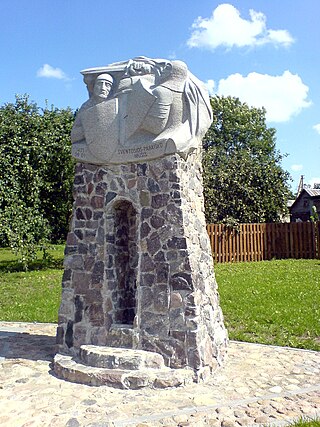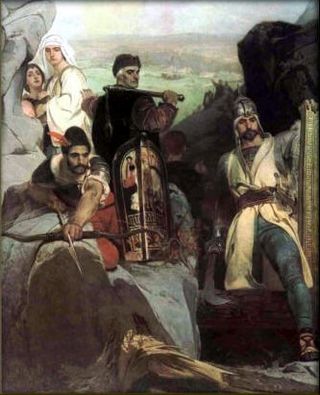External links
- Page at Condottieri di ventura (in Italian)
The Battle of Soncino was a battle of the Wars in Lombardy, fought in March 1431. It was fought between the armies of the Republic of Venice, under Count of Carmagnola, and of the Duchy of Milan, under Francesco I Sforza.
The Milanese victoriously ambushed the Venetians, and captured 1,500 cavalry and 500 infantry.

Frederick was the last Burgrave of Nuremberg from 1397 to 1427, Margrave of Brandenburg-Ansbach from 1398, Margrave of Brandenburg-Kulmbach from 1420, and Elector of Brandenburg from 1415 until his death. He became the first member of the House of Hohenzollern to rule the Margraviate of Brandenburg.
The Battle of Tranter's Creek was fought on June 5, 1862, in Pitt County, North Carolina, as part of Union Maj. Gen. Ambrose E. Burnside's North Carolina expedition during the American Civil War.

Jean Poton de Xaintrailles, a minor noble of Gascon origin, was one of the chief lieutenants of Joan of Arc. He served as master of the royal stables, as royal bailiff in Berry and as seneschal of Limousin. In 1454 he was appointed a Marshal of France. Jean Poton was a leading figure on the French side in the Hundred Years War.

The Battle of Boydton Plank Road, fought on October 27–28, 1864, followed the Union Army's successful Battle of Peebles's Farm in the siege of Petersburg during the American Civil War. This follow up was a further success, with the Union Army able to seize the Boydton and Petersburg Plank Road and cut the South Side Railroad, a critical supply line to Petersburg, Virginia.

The Battle of Domažlice or Battle of Taus or Battle of Tausch was fought on 14 August 1431 as the part of the 5th crusade against Hussites. The crusade was sent to Bohemia after negotiations, held in Pressburg and Cheb, between Hussites and the emperor Sigismund had failed.

Clan Cameron is a West Highland Scottish clan, with one main branch Lochiel, and numerous cadet branches. The Clan Cameron lands are in Lochaber and within their lands lies Ben Nevis which is the highest mountain in the British Isles. The Chief of the clan is customarily referred to as simply "Lochiel".

The Battle of La Higueruela was fought in the vega of the river Genil near Granada on 1 July 1431 between the forces of John II of Castile, led by Álvaro de Luna, and troops loyal to Muhammed IX, Nasrid Sultan of Granada. The battle was a modest victory for the forces of Castile, with no territorial gain and failing to take Granada. Following this battle, John II of Castile installed Yusuf IV, grandson of Muhammed VI, as Sultan of Granada.

The Wars in Lombardy were a series of conflicts between the Republic of Venice and the Duchy of Milan and their respective allies, fought in four campaigns in a struggle for hegemony in Northern Italy that ravaged the economy of Lombardy. They lasted from 1423 until the signing of the Treaty of Lodi in 1454. During their course, the political structure of Italy was transformed: out of a competitive congeries of communes and city-states emerged the five major Italian territorial powers that would make up the map of Italy for the remainder of the 15th century and the beginning of the Italian Wars at the turn of the 16th century. They were Venice, Milan, Florence, the Papal States and Naples. Important cultural centers of Tuscany and Northern Italy—Siena, Pisa, Urbino, Mantua, Ferrara—became politically marginalized.

James Butler, 5th Earl of Ormond, Earl of Wiltshire was an Anglo-Irish nobleman and soldier. Butler was a staunch Lancastrian and supporter of Queen consort Margaret of Anjou during the Wars of the Roses. He was beheaded by the victorious Yorkists following the Battle of Towton.

Niccolò Mauruzzi, best known as Niccolò da Tolentino was an Italian condottiero.
Taddeo Manfredi was Lord of Imola from 1448 until 1473. As a condottiere, he was commander in the Florentine and Neapolitan (1448–1452) armies.

The Lithuanian Civil War of 1432–1438 was a war of succession to the throne of the Grand Duchy of Lithuania, after Vytautas the Great died in 1430 without leaving an heir. The war was fought on the one side by Švitrigaila, allied with the Teutonic Knights, and on the other by Sigismund Kęstutaitis, backed by the Kingdom of Poland. The war threatened to sever the Union of Krewo, the personal union between Poland and Lithuania. Švitrigaila's alliance with the Grand Master of the Teutonic Order, Paul von Rusdorf, launched the Polish–Teutonic War (1431–1435) but failed to secure victory for Švitrigaila.

The Battle of Corpach was a Scottish clan battle in which the Clan Cameron routed the Clan Maclean. It took place around 1470 at Corpach, just north of Fort William on the west coast of Scotland.

The Koinon of the Zagorisians, alternatively Commons of the Zagorisians, League of the Zagorisians, League of Zagori, or Nohaye Zagor in Turkish, was an autonomous region of the Ottoman Empire.

The Battle of Inverlochy (1431) was fought after Alexander of Islay, Lord of the Isles and Earl of Ross, had been imprisoned by King James I. A force of Highlanders led by Donald Balloch, Alexander's cousin, defeated Royalist forces led by the Earls of Mar and Caithness at Inverlochy, near present-day Fort William. Over 1000 men were supposedly killed, among them the Earl of Caithness. Balloch then went on to ravage the country of Clan Cameron and Clan Chattan, clans who had been disloyal to Alexander. King James himself soon after led an army into the Highlands, and Highland forces left off.

The Polish–Teutonic War (1431–1435) was an armed conflict between the Kingdom of Poland and the Teutonic Knights. It ended with the Peace of Brześć Kujawski and is considered a victory for Poland.

The Battle of Trnava or Battle of Nagyszombat took place during the Hussite Wars between the Hussites and the Hungarian-Royalists-Serbian army near Trnava (Nagyszombat) in the Kingdom of Hungary. The battle was fought in three phases, on 23, 25 and 28 April 1430 and ended in Hussite victory.

The Battle of Bulgnéville was fought on 2 July 1431. The battle was fought between two cousins, René I d'Anjou and Antoine de Vaudémont, over partition of the Duchy of Lorraine after the death of Duke Charles II. Although René was defeated and captured, the result was reversed by diplomatic means in the years following.

The Battle of Ilava took place during the Hussite Wars between the Hussites and the Hungarian-Royalists army near Ilava in Upper Hungary (Slovakia) on November 9, 1431.